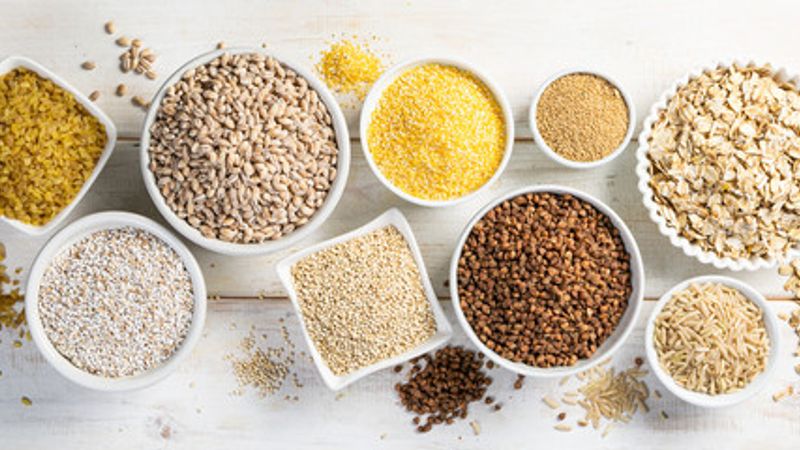

Our Review Process
Our articles undergo extensive medical review by board-certified practitioners to confirm that all factual inferences with respect to medical conditions, symptoms, treatments, and protocols are legitimate, canonical, and adhere to current guidelines and the latest discoveries. Read more.
Our Editorial Team
Shifa Fatima, MSc.
Author
Dr. Apoorva T, MHM.
MEDICAL ADVISOR
5 Whole Grains for Diabetes To Consume
One constant thing running on the minds of a person with diabetes is to be able to efficiently manage their blood sugar levels throughout the day by including low sugar grains in their diet. Avoiding any complications in terms of highs and lows would be ideal to be able to maintain an optimal HbA1c level. Several factors may affect one’s blood sugar levels. Even the normal range of blood sugars may not be the same for everyone as it depends on many aspects. Food, habits, sleeping, stress, exercise, etc are a few of the things that can contribute to the rise and fall. While this may seem like a doable list, it is a little more complicated than that. The nuanced aspects of managing this condition are not as simple as it seems. A proper diet is one of the best ways to be able to effectively manage the erratic nature of blood sugars. Also know about sugar diet chart.
Table of Contents
Are Whole Grains Good for Diabetes?
What is good and not good for a person with diabetes has quite clear-cut definitions. Essentially, someone with T1D or T2D is supposed to lay off carbs and sweets as that can cause great damage to their overall blood sugars. However, there is a certain number of carbs in any kind of food that we eat. Some amount of carbs is also necessary for the body to break down into glucose molecules for the muscles and organs to use in the form of energy. Also know about Indian diabetes diet.
Whole grains for diabetes are considered to be the best grains for diabetics such category of food that is incorporated in almost every meal in most households. Adding whole grains to the diet would be a noteworthy and smart move that would take you and your family one step towards leading a healthier lifestyle. These grains provide several benefits to people, with or without diabetes. They contain a lot of minerals and vitamins along with other nutrients that contain ample amounts of dietary fiber. Read more to know about diet for diabetes.

Why are Whole Grains Important to a Diabetes Diet?
Grains are an inevitable part of the diet in an Indian household. Therefore, finding the best grains for diabetes and every other member of the family would then be the task that needs to be undertaken. A common misconception associated with diabetes is that people would have to give up on the things that they love and enjoy and may not be able to eat them at all. That, however, is not true. While it is better if a person with diabetes avoids refined grains like maida, they can now also indulge in several other alternatives in the form of whole grain that would be more beneficial and have lesser disadvantages or health complications. Low-Carb Grains for Diabetes are important because-
They are loaded with fiber
- They help to lower the cholesterol levels and thus reduce the risk of heart disease
- Whole grains result in slower digestion and absorption of carbs. This, eventually, leads to a slower rising in blood sugars.
- Whole grains also have the potential to help you feel full for a longer time. This results in lesser eating spurts and better weight management.
- Whole grains are made up of three layers – bran, endosperm, and germ. These three layers provide the body with different nutrients and minerals. Antioxidants, starch, protein, vitamin B, healthy fats, etc are all present in these layers and whole grains are a source of them all. Also know about prediabetes diet.
Glycemic Index Whole Grains
Whole Grains provide a steady and slow release of glucose into the bloodstream. Barley (28), bulgur (48), buckwheat (45), brown rice (48), and quinoa all have low glycemic indexes (53). Blood cholesterol and blood sugar levels can be lowered and maintained with a diet high in whole grains.

What are the Healthy Grains that can be included in a Diabetes Diet Plan?
Looking for the best grains for diabetes in India is not a tough task with the ample options available in the market. Essentially, it is important to recognize the grains that are healthy and provide more nutritional options rather than the ones that only add carbs and starch. Refined grains are usually found in white rice, pasta, bread, maida, etc that can create blood sugar levels to rise exponentially. To choose the grains good for diabetes, these are the ones you can keep your eye on – Ragi, Barley, Oats, Buckwheat, and Quinoa.
1. Ragi
One of the best grains for diabetes, ragi helps in the control and prevention of spikes in blood sugars. One can use ragi in several different ways – for making roti, dosa, khichdi, etc. The primary benefits that this whole grain can provide would be the abundance of polyphenols and dietary fibers as opposed to rice, corn, or even wheat. Ragi also has a low glycemic index which is overall a helpful statistic to have for a person with diabetes. Use this whole grain as a part of your diet in the morning or for lunch. Also read about how to prevent diabetes.
2. Barley
Another ancient grain that, although may not be very popular but is considered one of the healthiest ones. In the search for whole grains for diabetes, barley can be one of the leading contenders. Often considered a ‘superfood’ because barley has a special mixture of dietary fibers that help keep one satiated and also maintain a check on the blood sugar levels. Studies have also shown that eating barley is associated with an increased metabolism and insulin sensitivity.
3. Oats
Popularly known as a staple breakfast food, oats often come on the list of which grain is good for diabetes. Only a half-cup of cooked oatmeal can be equivalent to a one-ounce serving of whole grains. These grains are known to help stabilize blood sugars and reduce the risk of T2D. The presence of beta-glucan in these grains delays the rise in sugars post meals. They are also low in carbs and are known to bring down the overall cholesterol levels among people with diabetes.
4. Buckwheat
A simple switch to buckwheat from regular white flour will provide a much-needed boost to the soluble fiber content in the diet plan. One of the best among which grains are good for diabetes in India, buckwheat, and its soluble fiber, helps regulate blood sugars and glucose levels. Buckwheat is also associated with better glucose tolerance levels. It also contains iron, and fibers, and has a medium GL.
5. Quinoa
Quinoa, which is a rich whole grain for diabetes, cannot be ignored. It can be a delicious addition to your menu as it gives you several different options on how it can be used. Not only is it nutritious but it is also rich in fiber and protein. It helps in appetite control and can keep you set on an optimal calorie diet. Incorporate into salads, Rotis, upma, khichdi, etc, and enjoy the meal.
6. Bulgur
A commonly recommended gain for people with diabetes, bulgur is considered an excellent addition to the diet plan as it is rich in fiber and low in fat. Not only with weight control, but bulgur can also help optimize the levels of blood sugars in the body making it highly suitable for a person planning a diabetic diet. It also has an overall low glycemic index making it one of the best-suited grains – as it is low in carbs. You can consume this whole grain in salads, simmered in milk, used in porridge, and can also be added to bread. It is recommended also in a pre-diabetic diet. Know about Indian breakfast for diabetes .
Are Whole Grains Good for Diabetes Prevention?
There is strong research-based evidence that shows that people who eat more whole grains are less likely to develop type 2 diabetes. Since this type of diabetes is often caused by unhealthy lifestyles and habits, controlling diet can play a huge role in the overall prevention.
- Whole grains are considered the best grains for diabetes in India because they can help control blood glucose levels
- They cause a slower increase in blood sugars
- They put less stress on the body to produce insulin and therefore, prevent insulin resistance
- Are rich in vitamins, minerals, and phytochemicals
- Help in losing weight
- Lowers bad cholesterol and increases good cholesterol.
Bottomline
The benefits of whole grains in a daily diet cannot be overstated. They prove to be beneficial not only for people with lifelong conditions like diabetes but can also be helpful for everyone. The numerous advantages associated with these grains, however, can play a huge role in diabetes-related issues and long-term complications. There are different ways in which whole grains can be incorporated into the diet at different times. Nutrition, along with taste, what else does one need?
FAQs
1. What Grains should people with Diabetes Avoid?
Any refined grains should be avoided by a person with diabetes as the refined grains only contain the endosperm layer which is the middle, starchy, and mostly consists of carbohydrates.
2. Do Whole Grains Spike Blood Sugar?
No, whole grains, because are high in fiber and proteins, do not cause a dramatic spike in blood sugars. They cause a slow increase which can be easily countered by the bolus insulin shot if needed. Also know more about diabetes diet chart.
3. Which Grain has the Lowest Glycemic Index?
Several whole grains have low GIs, barley, buckwheat, oats, etc are some of them. These grains can help maintain a healthy level of blood sugars and can control any long-term damage due to unhealthy food.
4. Is whole wheat or whole grain better for diabetics?
Whole grains are usually considered the smarter choice for a person with diabetes as they are better for managing the overall glucose levels in the body due to their lower glycemic index. Since wheat has gluten, the carb content increases and this can lead to a spike in the overall blood sugar levels after consumption.
Disclaimer
This website's content is provided only for educational reasons and is not meant to be a replacement for professional medical advice. Due to individual differences, the reader should contact their physician to decide whether the material is applicable to their case.








